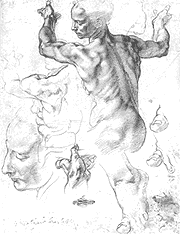| back to: Chapter 4 
Self-Portrait
Kathe Kollwitz
charcoal drawing
1924 (German Expressionist)

Study for Libyan Sibyl
Michelangelo
red chalk drawing
1510-11 (Italian Renaissance)
World Trade Center Memorial Competition
|
Chapter 5: Drawing
Drawing Materials
- DRY MEDIA
- silverpoint is the use of a silver to mar a surface. The silver tarnishes and the image becomes darker over time. hatching and cross-hatching are traditionally used to create value.
- pencil were originally lead, now most are graphite.
- charcoal is a material that is made from burnt wood. Handmade charcoal for artists is still produced in traditional fashion. Kathe Kollwitz's Self Portrait is an excellent example of a charcoal drawing.
- chalk and pastel are drawing sticks that are composed of pigment and a binder (like gum arabic). Michelangelo's Study for the Libyan Sibyl is an excellent example of a chalk drawing.
- crayon is a material with pigment and a wax binder. Variations like ContÈ crayon have heavier amounts of pigment and are made for artists' use.
- FLUID MEDIA
- pen and ink is the use of ink with a sharpened instrument.
- pen and wash is the use of full and partially-diluted ink to create a drawing.
- brush and ink is the use of ink with a brush.
- brush and wash the use of black and diluted ink. This process was practiced in ancient China and Japan on silk. It can be seen in this Japanese landscape by Sesshu, from about 1495.
- CARTOONS
The word cartoon is derived from the Italian "cartone" meaning paper. Practitioners of cartooning work to capture the essence of an image and simpify it. Often times these are shown as caricatures. Honore Daumier, an early political cartoonist, printed a cartoon lampooning King Louis-Phillippe of France. In return, Louis put Daumier in jail for six months. In this satirical cartoon, Gargantua, Daumier shows King Louis-Phillipe as a ravenous monster who is devouring all of France's wealth, food, etc. to satisfy his own appettite.
- OTHER NOTATIONS ON DRAWING
- Edmund Burke
-philosopher and social critic who wrote about the "sublime"
-he saw unfinished and preparatory works as superior to finished works because they allowed a viewer to include their own thoughts
- Paper
-The fibers of the paper provide drawing materials with their effectiveness in the creation of marks. Most artist papers are 100% fiber with no glues or fillers.
A process called electron bonding takes place on the atomic level as water is pressed from the wet pulp which makes the fibers adhere to each other.
Chapter 6
| |
|
